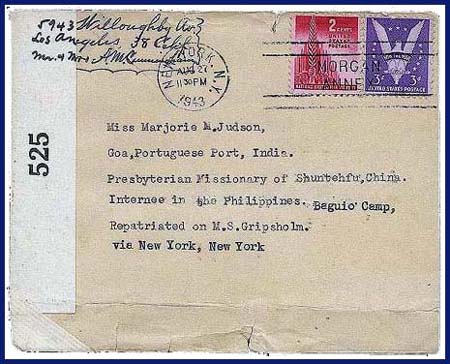Page section
mentioned above reproduced here under for the benefit of those
who do not
have a copy of Garrett's book entitled
A POSTAL
HISTORY OF THE JAPANESE OCCUPATION OF THE PHILIPPINES, 1942-1945
The third voyage
of GRIPSHOLM carried out the last diplomatic exchange in the Far
East, and was the first in which mail was brought out from American prisoners
in the Philippines on the return trip to the United States. GRIPSHOLM sailed
from New York on September 2, 1943 bound for Goa, with port calls at Rio
de Janiero, Brazil; Montevideo, Uruguay; and Port Elizabeth, Union of South
Africa. Aboard was another group of 1,517 Japanese and 8 other enemy nationals
to be exchanged for 1,724 Allied nationals, together with relief supplies
and mail. Rendezvous was made with TEIA MARU at Mormugao on October 15,
1943.
Prior to the
departure of TEIA MARU from Yokohama on September 13, 1943, newspapers
in Japan carried notices for the benefit of citizens who had relatives
interned in Allied Nation civilian internment camps, advising that an opportunity
for an exchange of mail was near at hand. The newspaper "Mainichi Shimbun"
in its edition of August 22, 1943 (Figure 165) published an article urging
that post cards should be written and posted quickly so as not to miss
the opportunity; although not specified, the "opportunity" was the departure
of TEIA MARU for the rendezvous with GRIPSHOLM. The article also advised
that it would henceforth be possible to send post cards once a month from
Japan to Japanese internees aboard in the U.S.A. and England.
After departing
Yokohama on September 13,1943, TEIA MARU called at Shanghai on September
20, where 1,048 nationals of the United States, Great Britain, Canada,
Chile and other Allied Nations were boarded. After departing Shanghai,
TEIA MARU made a port call at Hong Kong on September 22, from which port
she departed the following day after boarding 146 enemy nationals and 182
Filipinos. On September 26, 1943 she called at San Fernando, La Union,
in the Philippines, where 152 civilian repatriates climbed aboard the ship's
ladders from launches in San Fernando Bay. Also boarded at San Fernando
were many bags of mail from prisoners and internees in the Philippines.
Details concerning
the repatriates from the Philippines are recorded in the following account:
"On August
27th [1943], the Official Minutes of the Executive Committee [of internees
at Santo Tomas] stated that the exchange ship TEIA MARU would leave Manila
during the last week of September bound for Mormugao, in Goa, where connections
would be made with an exchange ship from the United States. The TEIA MARU
was said to be a fine new vessel of 17,000 tons, capable of taking care
of the entire party of repatriates, which was estimated to be some 350
in number. It was also announced September 13th that a confidential list
was being made of the internees to be repatriated. These were chosen primarily
from a list received by Tokyo from Washington with substitutes filled in
by the Japanese Bureau of External Affairs in Manila. Events now moved
rapidly, and on Sunday, September 26,1943, the repatriation party, 127
in number, left camp, escorted by Mr. Ohashi of the Commandant's staff
at Santo Tomas Internment Camp to board the TEIA MARU at an undisclosed
Philippine port. The group was joined by twenty-four members of the consular
staff and one internee from Baguio, making a total of 151 adults and one
infant. Of these, 131 were Americans, 15 Canadians, and 6 nationals of
other allied countries."
TEIA MARU departed
San Fernando on September 26 and made port calls at Saigon and Singapore
en route to Mormugao. The exchange with GRIPSHOLM was completed on October
15,1943 and TEIA MARU departed Mormugao on October 21. She called at Singapore
(renamed "Shonan" by the Japanese), from which port she departed November
2, en route to Manila. The Hong Kong News of Sunday, November 7, 1943 carried
word of her impending arrival in Manila:
"EXCHANGE
SHIP DUE IN MANILA
Manila, Nov.
5 (Domei) —The exchange ship, Teia Maru, with 1700 repatriates from North,
Central and South America, is scheduled to arrive here tomorrow.... It
will be recalled that the Teia Maru called at North San Fernando on September
26, where it picked up more than 100 enemy nationals returning to their
homeland from the Philippines, before sailing to Goa."
Another report
described the entry of TEIA MARU into Manila Harbor:
"The TEIA MARU
arrived in Manila on November 6. According to the TRIBUNE, there were 1,350
Japanese nationals aboard, and when the ship was passing Corregidor, a
naval officer who had boarded the ship climbed to the bridge and began
explaining the details of the former American stronghold through a megaphone.
The returning Japanese saw the battleground where the American Forces were
crushed and forever swept out of East Asia. Slowly the ship proceeded toward
Pier 5, Manila." |
